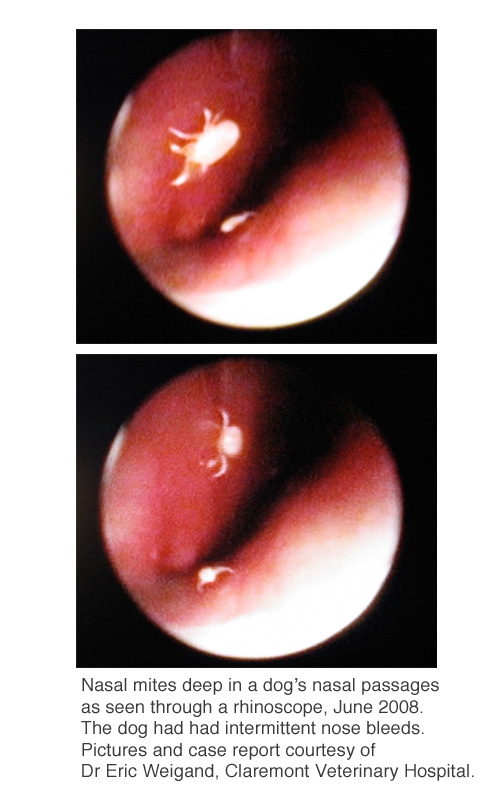A Case of Canine Nasal Mites in a
Golden Retriever, June 2008
Case Details. In June 2008, a 10 year old
Golden Retriever was presented to Dr Eric Weigand of
Claremont Veterinary Hospital for intermittent nose
bleeds. The owner of the dog said it was unlikely
anything had become caught up the nose, such as grass
awns (a.k.a foxtails).
Initially a bleeding nasal tumor or blood clotting
disorder were suspected as possible causes of the nose
problem because the dog was known to have liver cancer.
However, blood clotting tests were normal.
 The
dog was anesthetized for rhinoscopy (nasal scoping).
Several canine nasal mites were seen walking about
inside the lining of the nasal passages deep inside the
nose. After further evaluation of the dog, it was
determined that it was safe to administer weekly
injections of ivermectin. The nosebleeds resolved within
48 hours of the first treatment. The dog later succumbed
to the previously diagnosed liver cancer.
The
dog was anesthetized for rhinoscopy (nasal scoping).
Several canine nasal mites were seen walking about
inside the lining of the nasal passages deep inside the
nose. After further evaluation of the dog, it was
determined that it was safe to administer weekly
injections of ivermectin. The nosebleeds resolved within
48 hours of the first treatment. The dog later succumbed
to the previously diagnosed liver cancer.
Disease Overview. Canine nasal mites (species
name Pneumonyssoides caninum) are a type of mite that
lives in the nasal passages of dogs. It is found in dogs
worldwide. The lifecycle of canine nasal mites are not
completely understood, but it is presumed the mites can
be transmitted from dog-to-dog.
Symptoms of canine nasal mite infestation in dogs may
include nasal discharge, itchiness of the face,
sneezing, reverse sneezing, and nose bleeds. The only
way to be certain a dog has nasal mites is to perform a
nasal scoping or a deep nasal flushing. Certain
antiparasitic medications can successfully treat the
infection.
Local Data. None. It is unknown how common
nasal mites are in dogs because individual cases are not
reportable. Studies in Norway and Sweden found that
between 7-20% of dogs were infected.
Human Health Risk. This mite is not considered
contagious to people.
Acknowledgements. Veterinary Public Health
greatly appreciates Dr. Weigand’s reporting of this case
and his sharing of these images.
(Posted 10/1/08)
PRINTABLE VERSION

SHORT VIDEO OF NASAL MITES (5.6 MB, .avi file)
References
1. The Merck Veterinary Manual Online. Canine Nasal
Mites. Available at
this link (initially accessed 9/25/08).
2. Gunnarsson LK et al (2001). Prevalence of
Pneumonyssoides caninum infection in dogs in Sweden.
Jour Amer Anim Hosp Assoc 37(4):331-337.
3. Bredal WP. (1998). The prevalence of nasal mite (Pneumonyssoides
caninum) infection in Norwegian dogs. Vet Parasit.
76:233-237.